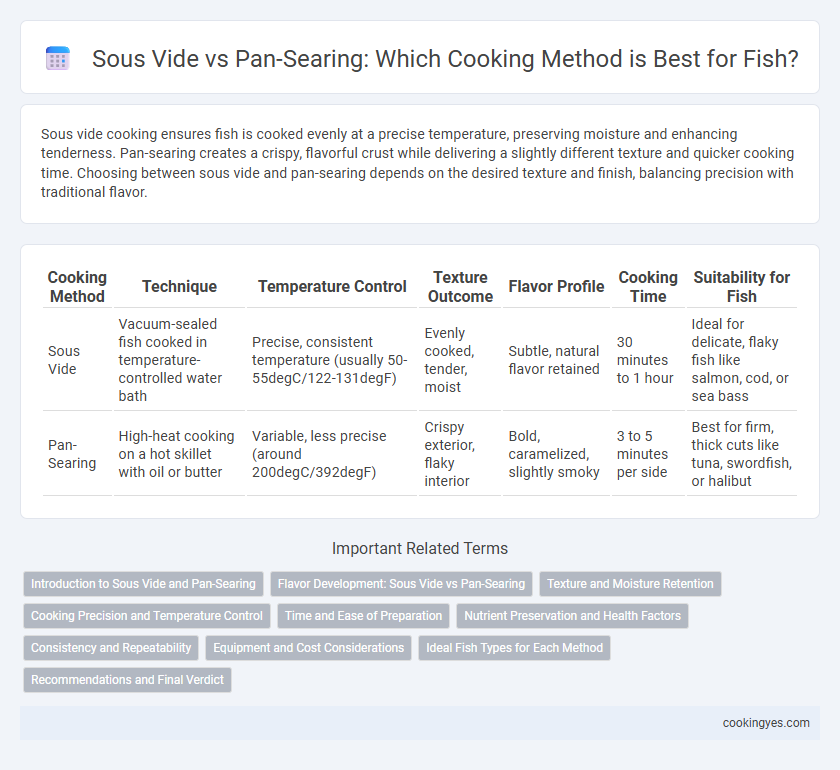Sous vide cooking ensures fish is cooked evenly at a precise temperature, preserving moisture and enhancing tenderness. Pan-searing creates a crispy, flavorful crust while delivering a slightly different texture and quicker cooking time. Choosing between sous vide and pan-searing depends on the desired texture and finish, balancing precision with traditional flavor.
Table of Comparison
| Cooking Method | Technique | Temperature Control | Texture Outcome | Flavor Profile | Cooking Time | Suitability for Fish |
|---|---|---|---|---|---|---|
| Sous Vide | Vacuum-sealed fish cooked in temperature-controlled water bath | Precise, consistent temperature (usually 50-55degC/122-131degF) | Evenly cooked, tender, moist | Subtle, natural flavor retained | 30 minutes to 1 hour | Ideal for delicate, flaky fish like salmon, cod, or sea bass |
| Pan-Searing | High-heat cooking on a hot skillet with oil or butter | Variable, less precise (around 200degC/392degF) | Crispy exterior, flaky interior | Bold, caramelized, slightly smoky | 3 to 5 minutes per side | Best for firm, thick cuts like tuna, swordfish, or halibut |
Introduction to Sous Vide and Pan-Searing
Sous vide cooking involves vacuum-sealing fish and immersing it in a precisely controlled water bath, ensuring even doneness and enhanced flavor retention. Pan-searing fish uses high heat in a skillet to create a crispy exterior while preserving a tender interior, emphasizing quick cooking and texture contrast. Both methods offer unique advantages for achieving optimal fish texture and taste.
Flavor Development: Sous Vide vs Pan-Searing
Sous vide cooking preserves the delicate, natural flavors of fish by gently cooking it at a precise low temperature, resulting in tender and evenly cooked flesh. Pan-searing enhances flavor through the Maillard reaction, creating a crispy, caramelized crust that adds depth and complexity to the taste. Combining sous vide with a quick pan-sear offers the best of both techniques, delivering moist, flavorful fish with a savory, golden exterior.
Texture and Moisture Retention
Sous vide cooking ensures precise temperature control, resulting in fish with an evenly tender texture and superior moisture retention. Pan-searing creates a crispy, flavorful crust but risks drying out the fish's interior due to higher direct heat exposure. For optimal balance, sous vide maintains juiciness while pan-searing enhances texture through caramelization.
Cooking Precision and Temperature Control
Sous vide offers unparalleled cooking precision and consistent temperature control, ensuring fish is cooked evenly to the exact desired doneness without risk of overcooking. Pan-searing provides high heat that creates a flavorful crust but requires careful attention to avoid temperature fluctuations that can lead to uneven cooking. For temperature-sensitive fish, sous vide is the optimal method to maintain moistness and texture through precise temperature regulation.
Time and Ease of Preparation
Sous vide cooking ensures precise temperature control and consistent doneness but requires longer cooking times, often between 30 minutes to 1 hour or more, while pan-searing delivers rapid cooking in 5 to 10 minutes with a crisp, flavorful crust. Sous vide demands minimal active attention once the fish is sealed and submerged, making it easy for multitasking, whereas pan-searing requires constant monitoring and skillful timing to avoid overcooking or burning. For time-efficient meals, pan-searing is preferred; for effortless precision and tenderness, sous vide excels despite the extended cooking duration.
Nutrient Preservation and Health Factors
Sous vide cooking preserves nutrients in fish more effectively by using precise, low-temperature water baths that minimize nutrient loss and retain omega-3 fatty acids. Pan-searing, while providing a flavorful crust through high heat, can lead to greater nutrient degradation and the formation of potentially harmful compounds like advanced glycation end products (AGEs). Choosing sous vide enhances retention of vitamins such as B12 and D, supporting better health outcomes compared to the traditional pan-searing method.
Consistency and Repeatability
Sous vide cooking ensures precise temperature control, resulting in consistently tender and evenly cooked fish with minimal risk of overcooking. Pan-searing offers a flavorful crust but often leads to variability in doneness due to inconsistent heat distribution and reliance on cook time estimation. For repeatable results, sous vide provides a reliable method that maintains texture and moisture across multiple cooking sessions.
Equipment and Cost Considerations
Sous vide cooking requires specialized equipment such as immersion circulators and vacuum sealers, which can range from $100 to $500, leading to a higher initial investment compared to pan-searing. Pan-searing only needs a good-quality skillet or frying pan, making it a more budget-friendly option with lower upfront costs typically under $50. While sous vide offers precision and consistency, the affordability and accessibility of pan-searing remain attractive for everyday fish preparation.
Ideal Fish Types for Each Method
Tender, delicate fish like salmon, cod, and sea bass benefit from sous vide cooking, which preserves moisture and enhances natural flavors through precise temperature control. Firmer, thicker fish such as tuna, swordfish, and halibut are well-suited for pan-searing, where high heat develops a crispy, caramelized crust while maintaining a juicy interior. Choosing the right method based on fish type ensures optimal texture and taste, highlighting each variety's unique qualities.
Recommendations and Final Verdict
Sous vide ensures precise temperature control, resulting in evenly cooked, tender fish with enhanced moisture retention. Pan-searing delivers a crispy, flavorful crust due to Maillard reaction, ideal for those seeking texture contrast. For optimal results, use sous vide for delicate, flaky fish and finish with a quick pan-sear to combine tenderness with a golden, savory exterior.
Sous vide vs pan-searing for cooking methods Infographic

 cookingyes.com
cookingyes.com